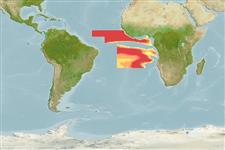>
Argentiniformes (Marine smelts) >
Microstomatidae (Pencil smelts)
Etymology: megalopa: Named for the extraordinarily large eye.
Eponymy: Fridtjof Nansen (1861–1930) was a Norwegian explorer, scientist, diplomat and later recipient of the Nobel Peace Prize. [...] (Ref. 128868), visit book page.
Environment: milieu / climate zone / depth range / distribution range
Ekologi
marina batypelagisk; djupintervall 0 - 1300 m (Ref. 5123). Deep-water; 10°N - 20°S
Eastern Atlantic: Ascension Island.
Size / Vikt / Age
Maturity: Lm ? range ? - ? cm
Max length : 14.0 cm SL hane/ej könsbestämd; (Ref. 5123)
Short description
Bestämningsnycklar | Morfologi | Morfometri
Mjukstrålar i ryggfenan (totalt) : 9 - 10; Mjukstrålar i analfenan: 8 - 10; Ryggkotor: 44 - 45. Branchiostegal rays 4. Eye very large, eye diameter to snout length ratio > 2 to 1 (Ref. 5123).
A specimen of 12.65 cm SL had ripe ovarian eggs (Ref. 5123).
Life cycle and mating behavior
Könsmognad | Reproduktion | Lek | Ägg | Fecundity | Larver
Kawaguchi, K. and J.L. Butler, 1984. Fishes of the genus Nansenia (Microsomatidae) with descriptions of seven new species. Los Angeles County Mus. Contr. Sci. 352:1-22. (Ref. 5123)
IUCN Red List Status (Ref. 130435: Version 2024-1)
Threat to humans
Harmless
Human uses
Verktyg
Special reports
Download XML
Internet-källor
Estimates based on models
Preferred temperature (Ref.
123201): 1.9 - 2.7, mean 2.5 °C (based on 618 cells).
Phylogenetic diversity index (Ref.
82804): PD
50 = 0.5000 [Uniqueness, from 0.5 = low to 2.0 = high].
Bayesian length-weight: a=0.00389 (0.00180 - 0.00842), b=3.12 (2.94 - 3.30), in cm total length, based on all LWR estimates for this body shape (Ref.
93245).
Trofisk nivå (Ref.
69278): 3.3 ±0.4 se; based on size and trophs of closest relatives
Fishing Vulnerability (Ref.
59153): Low vulnerability (10 of 100).
